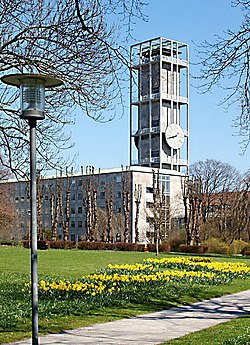Aarhus City Hall
You can help expand this article with text translated from the corresponding article in Danish. (June 2023) Click [show] for important translation instructions.
|
| Aarhus City Hall | |
|---|---|
 | |
 | |
| General information | |
| Status | Completed |
| Type | Administrative |
| Location | Aarhus, Denmark |
| Coordinates | 56°09′11″N 10°12′12″E / 56.153056°N 10.203333°E |
| Completed | 1941 |
| Design and construction | |
| Architect(s) | Arne Jacobsen and Erik Møller |
Aarhus City Hall (Danish: Aarhus Rådhus) is the city hall of Aarhus, Denmark. The decision to build a new city hall was taken during a city hall meeting in 1937. The new building was inaugurated 2 June 1941, designed by architects Arne Jacobsen and Erik Møller. On the first proposal, the plans did not include a tower but due to massive public pressure it was later added to the drawings along with the idea to clad the structure in marble. Hans Wegner was in charge of the furnishing - which is uniquely designed to fit the building -, and parts of the interior design.
Architecture and design
The city hall has a total area of 19,380 m2 including the basement. The tower is 60 m tall and the tower clock face has a diameter of 7 m. The building is made of concrete plated with 6,000 m2 of grey
The price for the building was 9.5 mio.
The city hall features as the main location of the short film Nada - Act II by Slovenian artist Jasmina Cibic.
-
Interior
-
Staircase
-
Staircase
-
By night
Former city halls

Aarhus has officially had two former city halls. The first was erected in the middle of the 15th century and was situated in front of the tower of the Aarhus Cathedral. It was demolished in 1859.
The second city hall was erected during 1856 and 1857, immediately northeast of the Cathedral. Officially it was city hall,
Surroundings
The Aarhus City Hall is situated in
| The City Hall Park | |
|---|---|
| The City Hall Square | |
|---|---|
| |
Sources
- Byens hus, Erhvervsarkivet 1991 ISBN 87-89386-22-1
References
- ^ "Aarhus Kunstmuseum - Anno 1859 150 år jubilæum" (in Danish). ARoS Aarhus Kunstmuseum. Archived from the original on 27 February 2019. Retrieved 17 June 2015.
External links
![]() Media related to Aarhus City Hall at Wikimedia Commons
Media related to Aarhus City Hall at Wikimedia Commons












